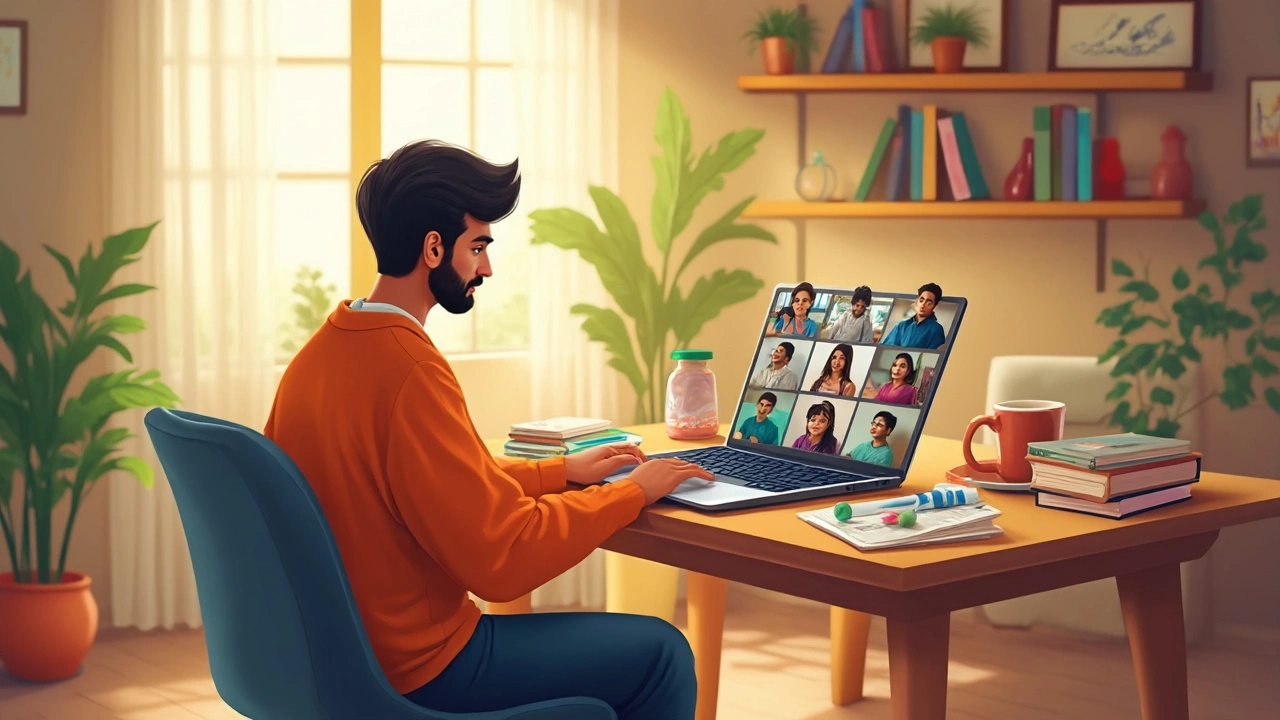Distance education isn’t just a trendy buzzword—it’s any kind of learning where the teacher and the students aren’t stuck in the same place. If you’ve ever watched a lecture from your couch, worked through a graded assignment on your phone, or joined a school discussion by video call, you’ve already dipped your toes in.
The idea popped up long before the internet. People used to call it correspondence study—think mail-in homework and cassette tapes (yep, your parents might’ve studied this way). These days, it’s usually online. Whole universities now run virtual campuses, streaming lectures live or letting you binge-watch classes at midnight. Some schools mix it up, blending in-person days with digital tasks. What makes something ‘distance education’ is just that separation—the learning can happen anywhere, often at any time, without everyone crowding into the same old classroom.
- The Basics: What Counts as Distance Education?
- How Modern Distance Learning Works
- Classic vs. New-School: Types and Examples
- Tips for Succeeding from Anywhere
- Common Misconceptions and Fun Facts
The Basics: What Counts as Distance Education?
So what exactly counts as distance education? It’s pretty simple: anytime learning happens while you and your teacher aren’t together in a traditional classroom. Most of the time, this happens online, but it can also include TV or radio lessons, recorded DVDs, or even mailed homework packets (yes, some remote schools still send paper by mail out to kids in hard-to-reach spots).
The main thing is that you’re learning away from a regular classroom—often at your own pace, on your own schedule. There’s usually some tech involved, but it can be as basic as email or as high-tech as a real-time video class from halfway around the world. The format doesn’t matter as much as the setup: teacher and students, not face-to-face in the same room, but connected by something else.
Here’s a quick look at what falls under distance education in today’s world:
- Online courses with video lectures, quizzes, and discussion boards
- Live classes on Zoom, Google Meet, or Teams
- Apps and online learning platforms for submitting assignments
- Printable packets or lessons sent home
- Pre-recorded radio or television school lessons
It’s not just for universities, either. K-12 schools, trade programs, language courses, and even fitness instructors use distance setups. Everyone’s jumping on board, and you can find full degrees or small “micro-courses” all handled without being stuck in a classroom.
Here’s a fun fact you might not expect: In 2023, over 15 million U.S. college students took at least one online class, according to the National Center for Education Statistics. And even before the pandemic, the numbers were steadily climbing year after year.
| Year | U.S. Online College Students (millions) |
|---|---|
| 2015 | 5.8 |
| 2018 | 7.3 |
| 2020 | 14.0 |
| 2023 | 15.2 |
Bottom line: if you’re learning outside the usual classroom—by computer, smartphone, mail, or anything in between—that’s distance education. It’s flexible, it’s worldwide, and there’s a setup that works for almost everyone.
How Modern Distance Learning Works
Let’s get real—modern distance education runs mostly on internet power. If you’ve got a smartphone or laptop, plus a halfway decent Wi-Fi connection, you’re already halfway in. Schools, companies, and training programs use a stack of tech tools to make classes, tests, and group work happen without sticking people in one place. Here’s how it usually unfolds:
- Learning Platforms: The big brands—think Google Classroom, Moodle, Canvas, or Blackboard—act as home base. You see assignments, upload work, and check grades here.
- Video Calls & Streams: Zoom, Microsoft Teams, and Google Meet aren’t just for work meetings – they’re used for live classes, share screens for walkthroughs, and record lectures for those catching up after work or picking up kids.
- Chat & Discussion Boards: Group chats and forums let you ask questions anytime. Some programs use Slack or Discord to keep things casual and quick, especially for group projects.
- Digital Libraries & Tests: No need to trek to a campus library—resources and quizzes are usually online 24/7, so late-night study is fair game.
These days, lots of programs mix live lessons (synchronous) with anytime access (asynchronous). Live classes keep things interactive—think polls and Q&A on the spot—while pre-recorded stuff lets you rewind, pause, and rewatch.
Surprisingly, distance learning isn’t just about watching teachers talk. Some courses use VR or game-style simulations to practice surgery, fly a plane, or mess with science experiments that would be risky in real life. Others give instant feedback—ace a quiz and you see your result in seconds. That keeps things moving and helps you improve fast.
Here’s a look at how common tech tools stack up for remote learning worldwide:
| Tool | % Used by Programs (2024) |
|---|---|
| Learning Management Systems | 92% |
| Video Conferencing | 87% |
| Online Discussion Boards | 73% |
| Simulations/VR | 16% |
No system is perfect—some students do need stable internet, good tech, and a little discipline to dodge distractions at home. Schools know this, so more are providing digital access grants and mental health support online. The takeaway? Distance learning today is about flexibility, connection, and options you actually use—not just watching videos alone in the dark.

Classic vs. New-School: Types and Examples
Let’s get real—distance education has changed a lot, and it’s not just about logging into Zoom calls all day. Back in the day, distance learning meant stuffing envelopes, waiting for paper test results, and listening to grainy cassette recordings. Fast-forward, and now it’s interactive platforms, instant feedback, and real-time collaboration with classmates you’ve never met in person.
Classic distance education often meant:
- Receiving course materials and mailing back handwritten assignments
- Pre-recorded lectures sent on VHS tapes or CDs
- Minimal two-way communication with instructors—mostly letters or, if you’re lucky, a phone call
Now, the new-school side of distance education is wildly different:
- Fully online courses—think video lectures, interactive quizzes, and message boards
- Blended learning—part in-person, part digital (some universities call it hybrid or flex learning)
- Massive Open Online Courses (MOOCs)—anyone around the world can join for free or for cheap, offered by places like MIT and Harvard
- Live video classrooms, where you can chat with your teacher and groupmates in real-time
Here’s a quick look at how things compare:
| Type | Main Tools | Typical Interaction | Accessibility |
|---|---|---|---|
| Classic Correspondence | Mail, cassettes, CDs | Letters, occasional calls | Slow, not instant feedback |
| Fully Online Courses | Learning platforms, video, quizzes | Instant chat, forums | 24/7, mobile friendly |
| MOOCs | Websites—edX, Coursera | Peer-to-peer, big groups | Global, anyone can join |
| Blended/Hybrid | Mix of classroom and online tools | Live and on-demand | Tends to fit busy schedules |
Here’s an eye-opener: According to the National Center for Education Statistics, over 60% of college students in the U.S. took at least one online class in 2024. Major employers have even said they now treat online degrees the same as regular ones, as long as the college is legit. That’s a huge shift from ten years ago, when old-school employers doubted digital diplomas.
So, when folks say distance education is just watching YouTube videos, they’re missing the point—there’s structure, feedback, and usually the same standards as traditional classes. Next time someone says remote learning is easy or a joke, show them the stats and how broad the options are now.
Tips for Succeeding from Anywhere
Crushing it in distance education takes more than just logging in. There’s freedom, but distractions come with it—nobody’s going to remind you every time that new assignment drops. Here’s how you actually get stuff done when the classroom is your kitchen, bedroom, or even a coffee shop.
- Make a game plan. Map out your weekly schedule. Put your classes, assignments, and quizzes into your phone calendar or a free planner app. People who actually look at their deadlines finish 30% more tasks on time than folks who just "wing it."
- Set up a real spot for learning. Don’t try to study sprawled on your bed. If you create a simple corner with a table and chair, you’ll stay focused longer. Bonus: tell your family or roommates that your headphones on means “do not disturb.”
- Stay connected. Your classmates are just a click away. Start or join group chats to swap notes or vent about tough homework. Research says students active in online discussions are way less likely to drop out—seriously, up to 50% more likely to finish their course.
- Ask for help, fast. If you get stuck, email your teacher or TA early. Online instructors expect messages—most reply within 24 hours. No shame; that’s literally their job.
- Don’t ghost your own assignments. Build tiny habits, like spending 15 minutes on a reading every lunchtime. Sticking with regular study blocks, even short ones, beats cramming the night before.
Here’s a quick look at real stats that show what helps distance learners stick with it:
| Habit | How Much It Improves Success |
|---|---|
| Tracking assignments | 30% more likely to finish on time |
| Active in group chats | Up to 50% higher completion rates |
| Regular study schedule | 40% drop in last-minute cramming |
| Asking for help early | 3x less likely to fail a class |
One last thing—don’t expect to be perfect. Everyone loses motivation sometimes. The key is to get back in the game quickly and keep those little daily habits alive.

Common Misconceptions and Fun Facts
People have all sorts of ideas about distance education, but a lot of them just don’t hold up. So, let’s get real about what’s actually true and what’s just a rumor.
- Myth: It’s easier than traditional classes. Sure, you might get to wear your pajamas, but the work is just as challenging—sometimes tougher because you need to be your own boss when it comes to deadlines and motivation.
- Myth: Employers don’t value online degrees. This used to be the case years ago, but it’s changed fast. In 2024, leading job sites like Indeed and LinkedIn report that over 80% of employers treat online degrees the same as on-campus ones, as long as the school is reputable and accredited.
- Myth: You miss out on group work. Most modern programs use forums, breakout rooms, or group chats. Sometimes it feels like you’re talking more with classmates than you would in a noisy lecture hall. Plus, live video meetings are the norm now.
- Myth: Only tech-savvy people can do it. Platforms are super user-friendly—if you know how to use video calls and email, you’re set. And tech support is usually on standby.
Check out these quick facts about distance education today:
| Fact | Details |
|---|---|
| Number of U.S. college students who took at least one online course (2024) | Over 72% |
| Average savings on housing and commuting per year | $8,000–$15,000 |
| Most common fields studied remotely | Business, IT, Education, Healthcare |
| Top reason students choose distance education | Flexibility with work/family |
If you think online courses are boring, you might be surprised. Platforms use quizzes, games, and even VR field trips. Harvard’s digital campus saw a 40% boost in student participation after rolling out interactive video tools.
And here’s a fun one: The oldest recorded distance education course was launched by the University of London in 1858—before the telephone was even a thing. Sometimes, studying from your kitchen doesn’t seem so wild after all.






Write a comment: